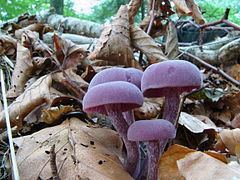Kingdom Fungi Scientific name Hydnangiaceae Rank Family | Division Basidiomycota Higher classification Agaricales Order Agaricales | |
 | ||
Lower classifications | ||
The Hydnangiaceae are a family of fungi in the Agaricales order of mushrooms. Widespread in temperate and tropical regions throughout the world, the family contains about 30 species in four genera. Species in the Hydnangiaceae form ectomycorrhizal relationships with various species of trees in both coniferous and deciduous forests.
Contents
Description
They may have fruit bodies with stipes and caps (pileate-stipiate), or gasteroid (with internal spore production, like puffballs). When pileate, the cap is smooth to scaly, sometimes striate, typically orange-brown or violet in color. The gills are widely spaced, thick, and waxy. In gasteroid forms, fruit body shape is irregular, with thin walls. Also, the peridium (the outer layer of the spore-bearing organ) is sometimes short-lasting (evanescent). Columella (the central, sterile part of the sporangium) may be absent or present, the hymenia are not gelatinized, and are formed in locules. Basidia are club-shaped (clavate), with two or four sterigmata, sometimes with accompanying cheilocystidia (cystidia on the edges of gills).
Distribution and habitat
Hydnangiaceae taxa have a widespread distribution in both temperate and tropical zones.
Ecology
Hydnangiaceae species are ectomycorrhizal, forming symbiotic relationships with various plant species, and have an important role in forest ecosystems.
